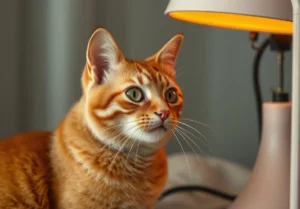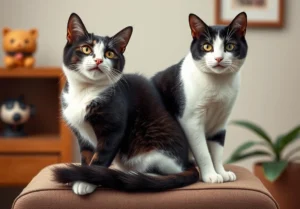Have you ever wondered why your cat curls up overnight? It’s a common behavior that many cat owners notice, but the reason behind it may not be immediately clear. In this blog post, we’ll explore the possible reasons why your feline friend chooses to sleep in a curled-up position.
Instinctual Behavior
Cats curling up overnight is a behavior deeply ingrained in their instincts. In the wild, felines would curl up to conserve heat and protect their vital organs while they sleep. This instinct has carried over to our domesticated cats, explaining why they often choose to sleep in a cozy, curled position.
Additionally, curling up can also be a way for cats to stay alert and ready to pounce if needed. By tucking their limbs close to their bodies and keeping their head low, cats are in a prime position to react quickly to any potential threats. So, if you find your kitty curled up tightly during the night, it’s likely their natural instincts at play, ensuring they are both comfortable and ready for action.
Comfort and Security
For cats, curling up can provide a sense of comfort and security akin to being in a safe den or nest. By curving their body into a tight ball, cats are able to feel more protected and secure, just like their wild ancestors would in a hidden spot in nature.
Moreover, curling up helps cats stay warm by minimizing the amount of body surface exposed to the air. This position allows them to trap their body heat efficiently, keeping them cozy and content throughout the night. So, if your feline friend curls up while sleeping, it’s likely their way of seeking comfort and security in your home environment.
Additional Unique Insight : Providing a soft blanket or bed for your cat can enhance their sense of security and comfort when curling up to sleep. Consider placing their favorite blanket in a quiet, warm corner of your house to create a cozy nesting spot for them. This simple gesture can make a big difference in how relaxed and secure your cat feels during their nighttime slumber.
Temperature Regulation
Cats curl up overnight primarily to conserve body heat. Just like when we tuck ourselves under a cozy blanket, a curled-up position helps retain warmth, especially during chilly nights. Your cat’s fur acts as a natural insulator, and by curling up, they create a smaller surface area exposed to the colder air, helping them stay warm. So, if you find your furry friend in a tight ball in the morning, they are likely just trying to stay toasty through the night.
Pain or Discomfort
When your cat curls up overnight, it could also be a subtle indication of pain or discomfort. Cats may instinctively assume a protective position when they are feeling unwell or sore, seeking a sense of security while they rest. If your cat frequently curls up in an unusual manner, it might be worth observing for other signs of discomfort, such as limping or lack of appetite. Consider seeking a veterinarian’s advice if you suspect your cat could be in pain, as they may need medical attention.
Additional Unique Insight: Another reason your cat might curl up overnight is to feel safe and secure. By tucking in their paws and tail, cats create a compact and protected space, akin to a cozy haven where they can relax and unwind without feeling vulnerable. So, don’t be surprised if your cat’s nighttime curling habit is simply their way of creating a comfortable and secure sleeping spot.
Sleep Quality
Curling up overnight may seem like your cat’s favorite sleeping position, but did you know it actually plays a crucial role in their sleep quality? When cats curl up tightly, it helps them conserve body heat, providing a sense of security and comfort. This position also allows cats to rest more soundly by keeping their vital organs protected. So, next time you see your feline friend snoozing in a tight ball, know that they are likely enjoying a cozy and restful slumber.
Curled Tail Significance
Have you ever noticed your cat’s tail position while curled up overnight? The way your cat tucks its tail can actually be quite telling about their mood and health. For example, a cat with a relaxed tail while curled up is likely feeling content and comfortable. On the other hand, a tightly tucked tail could indicate stress or anxiety. Keep an eye on your cat’s tail position while they sleep to better understand how they are feeling and address any potential issues early on.
Additional Unique Insight: Look out for twitching or wagging tails while your cat is curled up overnight. This could indicate they are dreaming or experiencing REM sleep, just like humans. It’s a fascinating glimpse into your cat’s inner world while they rest.
Go Easy on the Grooming: Avoid disturbing your cat when they are curled up overnight, especially if they are in a deep sleep. Cats value their beauty rest just like we do, so let them enjoy their peaceful slumber undisturbed.
Comfort is Key: Make sure your cat has a cozy and warm sleeping area where they can curl up comfortably overnight. Providing a soft blanket or a heated bed can enhance their sleeping experience and ensure they get the rest they need.
Encouraging Healthy Sleep Habits
Creating a comfortable and safe sleep environment for your feline friend is essential in promoting healthy sleeping habits. Make sure your cat has a cozy bed or blanket to curl up on, away from any loud noises or disruptions. Providing a quiet and peaceful space will help your cat feel secure and relaxed, enhancing their quality of sleep. Additionally, placing their bed in a warm and draft-free area will ensure they stay warm and comfortable throughout the night. Remember, a well-rested cat is a happy cat!
Fun Facts About Cat Behavior
Did you know that cats instinctively curl up in a ball when they sleep to conserve body heat and protect their vital organs? This position not only helps them stay warm but also makes them feel safe and secure. Cats are known for their adaptive behavior, and curling up overnight is just one of the many ways they ensure their own comfort and safety. So next time you see your cat all curled up, remember it’s their natural way of getting a good night’s rest!
- Cats have a unique ability to sleep for up to 16 hours a day, which is essential for their overall health and well-being.
- Contrary to popular belief, cats are not nocturnal but crepuscular, meaning they are most active during dawn and dusk.
- Cats are highly sensitive to their environment, so providing a consistent bedtime routine can help them feel more secure and relaxed during sleep.
- Some cats prefer to sleep in high places to feel safe from potential predators, while others seek out cozy corners for a more enclosed and secure sleep environment.
- Incorporating interactive playtime before bedtime can help your cat release pent-up energy and promote better sleep throughout the night.
Remember, understanding your cat’s behavior and sleeping habits can help you create a nurturing and comforting environment that promotes their overall well-being.
Interactive Play for Mental Stimulation
Engaging in interactive play with your feline friend can be a great way to keep them mentally stimulated and prevent boredom, which can lead to better sleep quality. Try incorporating toys that mimic hunting behaviors, such as feather wands or laser pointers, to engage your cat’s natural instincts. Puzzle feeders or treat-dispensing toys can also provide mental stimulation while rewarding your cat for problem-solving.
In addition, try rotating your cat’s toys regularly to keep them interested, as cats can quickly become bored with the same toys. Setting aside dedicated playtime each day can also help establish a routine and ensure your cat gets the mental exercise they need to rest well at night.
And remember, always supervise playtime to ensure your cat’s safety and avoid any potential hazards.
Additional Tip:
Consider creating a DIY scavenger hunt by hiding treats or toys around your home for your cat to find. This can provide mental stimulation and encourage your cat to explore their environment.
The Benefits of Understanding Your Cat’s Behavior
Taking the time to understand your cat’s behaviors and needs is essential for building a strong bond and providing the best possible care for your furry companion. By familiarizing yourself with your cat’s body language, vocalizations, and habits, you can better interpret their needs and preferences.
For instance, if your cat curls up overnight, it may be a sign of comfort and security, as cats instinctively protect their vital organs by sleeping in a curled position. Understanding this behavior can help you create a safe and cozy sleeping environment for your cat, ensuring they get the rest they need.
By developing a deeper understanding of your cat, you can strengthen your bond, anticipate their needs, and provide a loving, nurturing home that promotes their well-being.
Remember, every cat is unique, so pay attention to your cat’s individual preferences and behaviors to tailor your care to their specific needs.
For further reading:
Check out this comprehensive guide on decoding cat behavior from the American Association of Feline Practitioners: Cat Behavior Basics: A Guide for Cat Lovers
Alex, a passionate animal lover, has experience in training and understanding animal behavior. As a proud pet parent to two dogs and three cats, he founded AnimalReport.net to share insights from animal experts and expand his knowledge of the animal kingdom.




